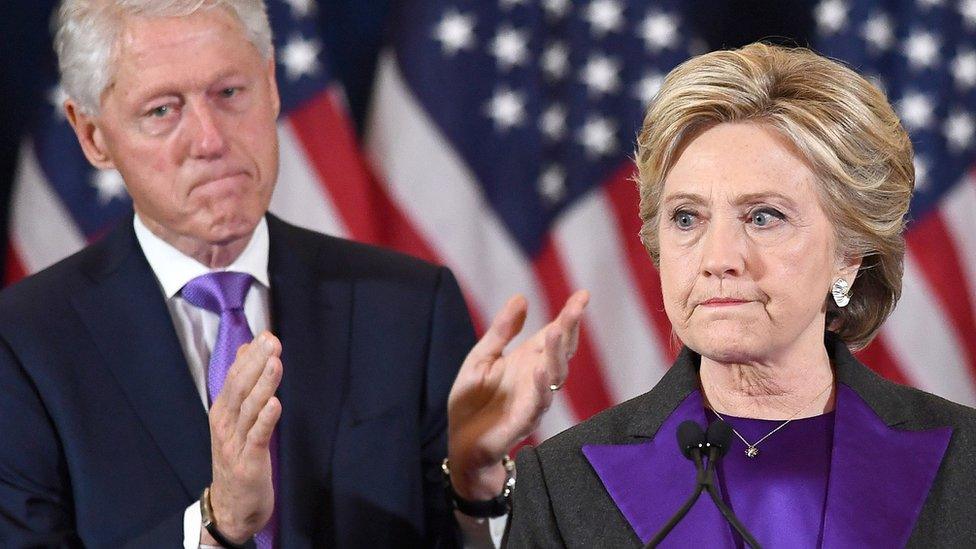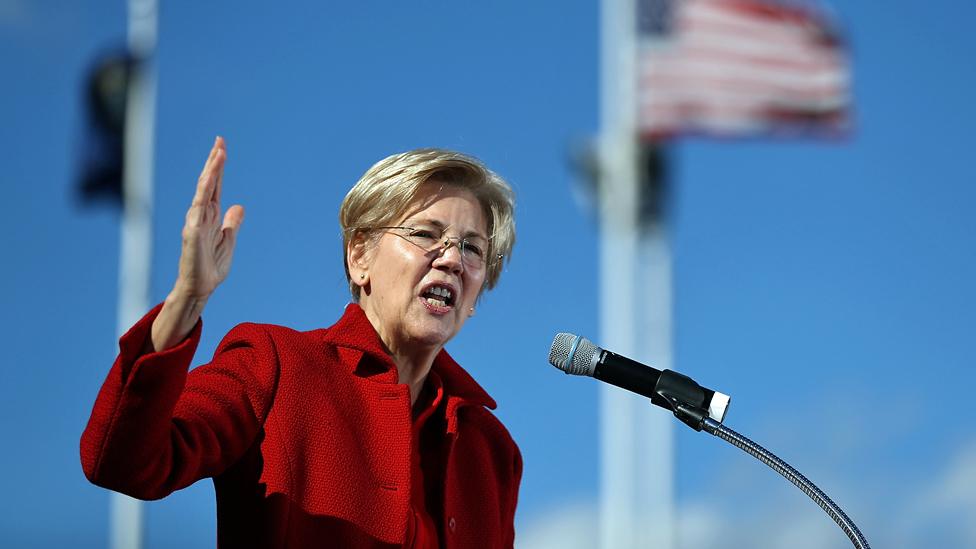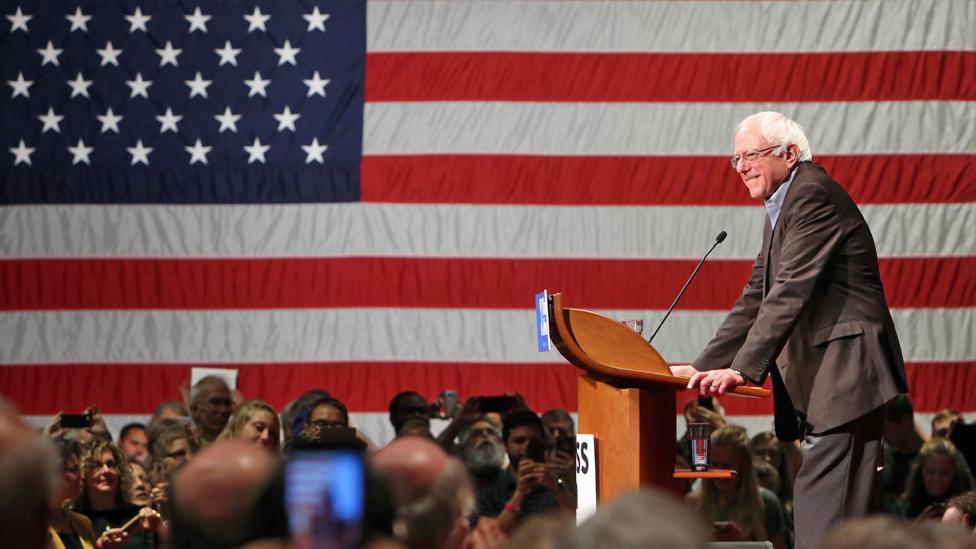US Election 2016 Results: A Democratic Party in disarray
- Published

The weather matched the mood of the Democratic faithful in New York the day after the electoral disaster - gloomy and grey.
As Hillary Clinton loyalists queued in the drizzle outside the downtown hotel where their candidate would formally concede the presidential election, they tried to wrap their heads around what had just happened to them and their party.
"I'm pretty heartbroken," said one young woman, brushing back a tear. "They hated more than we loved, and that's on us. That's how they won."
The previous night, as emotions at the Clinton campaign headquarters shifted from celebratory to despair, the attendees either refused to face reality - offering glib assurances that fortunes would turn in their favour soon enough - or responded to queries with stony silence.
The morning after, however, thoughts turned to the future and where their party should go from here.
"I think they have to try to get back some of the working class people they lost," says Karen Ubelhart. "We've been so focused on minorities, we've totally missed the disenfranchised white people. A lot of these people used to vote Democratic."
Narrow defeats in the Rust Belt states of Pennsylvania, Wisconsin and Michigan proved the mortal blow to the Clinton campaign, and the losing margins were due in part to Mr Trump's performance among the state's blue-collar rural voters. They had been a key component of the Democrat's winning presidential coalitions in both the 1990s and 2000s, but had been swept up by Mr Trump's populist movement.
"We need to regroup and figure it out," says Eve Harmon. "Maybe party politics is not even the way to talk about. What do we want to see this country be?"
She says the party should prioritise education reform - although she does have an ulterior motive, given that white voters without a college education were some of Mr Trump's most loyal supporters.
"Education really does matter because what I think we're seeing here is a lot of really uneducated people voting for somebody that they think will help them - and they're misinformed," she said.

Senator Elizabeth Warren of Massachusetts is 67 but considered a rising star by many in the party
As Mrs Clinton exits the stage, she leaves a Democratic Party that is in tatters. When Barack Obama won the presidency in 2008, he rode into office with large majorities in Congress and control of 29 of 50 governorships.
As he leaves, his party has lost control of Congress in two mid-term election routs - although they picked up some seats on Tuesday - and they will have governors in, at best, 16 states.
Their congressional leadership, New York Senator Charles Schumer and California Congresswoman Nancy Pelosi, are aging long-time legislators with little national appeal. Their outgoing vice-president, Joe Biden, is approaching his mid-70s. The Democratic stable is glaringly short of prize horses.
The party desperately needed Mrs Clinton to hold the White House and carry some new faces into power with her in order to be better positioned for the future.
Although the number of rising stars within the Democratic Party are few and far between, there are some names that will bubble up to the top of many lists.
Senators Elizabeth Warren of Massachusetts and Sherrod Brown of Ohio are likely to join Vermont's Bernie Sanders as the voices of the populist left. It's not exactly a young crowd, however, as Ms Warren is 67, Mr Brown is 64 and former presidential candidate Mr Sanders is 75.
New Jersey Senator Cory Booker was on Mrs Clinton's vice-presidential short list, and he's a master at firing up the partisan crowds. Kamala Harris has been on an upward track in California, and now she has a national stage as a newly minted senator, as has Nevada's Catherine Cortez Masto, the nation's first-ever Hispanic female senator.
Among the ranks of governors - traditionally a reliable source of presidential prospects - the list effectively begins and ends with Andrew Cuomo of New York. His speech to the Clinton faithful on Tuesday night sounded suspiciously like the opening salvo of a 2020 presidential campaign.

Many supporters of Bernie Sanders are adamant that he would have beaten Donald Trump
What lies in store for the Democrats, first and foremost, will be an attempt to define what went wrong. Plenty of blame will be heaped on Mrs Clinton and the centre-left establishment she represents.
Already there has been a torrent of second-guessing from the Sanders legions, who point to polls that showed their man beating Mr Trump in hypothetical head-to-head matchups last spring.
"Hate to say we told you so, but Bernie Sanders warned the Democratic Party, and it didn't listen; it sabotaged him," tweeted, external writer Ben Norton of the liberal website Salon.
Although the Vermont senator may not have held up to the glaring spotlight of the general election campaign, he would have presented a more difficult target for Mr Trump to label as the corrupt face of a seemingly despised status quo.
After that, there will be a rush to fill the party's leadership void.
Will Democrats decide that what's needed is a more ideologically pure standard-bearer, following the path of the British Labour Party, which selected Jeremy Corbyn after a similarly unexpected and thorough defeat in the UK general election last year? Or will a younger moderate with less political baggage than Mrs Clinton - someone like Mr Booker or Mr Cuomo - step to the fore?
Following the 2000 elections, Democrats faced a similar time of reckoning, shut out of every branch of the federal government and decimated at the state political ranks. It took them six years, an unpopular foreign war (Iraq) and a mishandled natural disaster (Hurricane Katrina) to claw their way back to the corridors of power.
All that progress has been lost, and the party will watch as Mr Trump and the Republicans take a machete to Barack Obama's political legacy.
Perhaps most concerning for Democrats is that although mid-term elections are usually friendly to the out-of-power party, the playing field in 2018 is notably inhospitable. While there are some big-state governorships, like Florida, coming up, the party will have to defend 10 Senate seats in states that Mr Trump won, including dark red West Virginia, North Dakota and Montana. Congress will almost certainly be out of reach until at least 2020.
For the Democrats, there could be a long and dark journey before they once again emerge from the political wilderness.